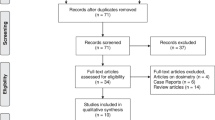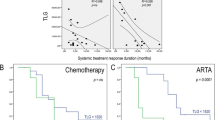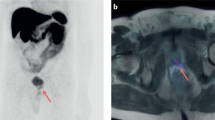Abstract
Purpose
To evaluate the differential impact of postoperative radiotherapy (RT) on recurrence patterns in patients treated with radical prostatectomy (RP) using [68Ga]Ga-PSMAHBED-CC conjugate 11 positron emission tomography (PSMA 11-PET).
Methods
We assessed 162 consecutive patients who experienced biochemical recurrence (BCR) after RP for nonmetastatic prostate cancer (PC). All had at least one positive lesion on imaging. No patient was on androgen deprivation therapy (ADT). Patients were categorized into those who had received adjuvant/salvage RT ± ADT and those who did not (RP only). Lesion- and patient-based analyses were performed. The impact of the radiation field was assessed.
Results
Overall, 57 BCR patients underwent RP only, 105 received postoperative RT. Median PSA was 1.01 ng/ml (IQR 0.58–2). In the lesion-based analysis, compared to the RP only patients, those who had received postoperative RT, had less lymph node (LN) recurrences distal to the common iliac bifurcation (35.2 vs. 57.9%, p = 0.05), but were more likely to harbor positive LNs proximal to the iliac bifurcation and in the presacral (34.2 vs. 12.3%, p = 0.002) areas as well as bone metastases (25.7 vs. 8.8%, p = 0.01). In the patient-based analysis, the patients with postoperative RT after RP had less recurrence in the pelvis only (pelvic LNs and/or prostate bed) (52.4 vs. 79%, p = 0.002), but were more likely to harbor extrapelvic recurrence (41.9 vs. 15.8%, p = 0.001). Patients who received RT to the prostate bed only had more recurrence to the pelvic LN only (54.2% vs. 23.4%, p = 0.002), but less extrapelvic recurrence (31.3 vs. 53.2%, p = 0.03) and less bone recurrence (16.7 vs. 36.2%, p = 0.031) compared to those patients, who received RT to the prostate bed and pelvic nodes.
Conclusions
Postoperative radiation treatment alters the recurrence pattern in BCR patients after RP. Further prospective studies are needed to establish a decision tree for optimal imaging/management according to previous treatments.
This is a preview of subscription content, access via your institution
Access options
Subscribe to this journal
Receive 4 print issues and online access
$259.00 per year
only $64.75 per issue
Buy this article
- Purchase on Springer Link
- Instant access to full article PDF
Prices may be subject to local taxes which are calculated during checkout

Similar content being viewed by others
References
Ferlay J, Colombet M, Soerjomataram I, Dyba T, Randi G, Bettio M, et al. Cancer incidence and mortality patterns in Europe: estimates for 40 countries and 25 major cancers in 2018. Eur J Cancer. 2018;103:356–87.
Cornford P, Bellmunt J, Bolla M, Briers E, De Santis M, Gross T, et al. EAU-ESTRO-SIOG guidelines on prostate cancer. part ii: treatment of relapsing, metastatic, and castration-resistant prostate cancer. Eur Urol. 2017;71:630–42.
Punnen S, Cooperberg MR, D’Amico AV, Karakiewicz PI, Moul JW, Scher HI, et al. Management of biochemical recurrence after primary treatment of prostate cancer: a systematic review of the literature. Eur Urol. 2013;64:905–15.
Stephenson AJ, Scardino PT, Kattan MW, Pisansky TM, Slawin KM, Klein EA, et al. Predicting the outcome of salvage radiation therapy for recurrent prostate cancer after radical prostatectomy. J Clin Oncol. 2007;25:2035–41.
Shariat SF, Semjonow A, Lilja H, Savage C, Vickers AJ, Bjartell A. Tumor markers in prostate cancer I: blood-based markers. Acta Oncol. 2011;50:61–75.
Giovacchini G, Picchio M, Briganti A, Cozzarini C, Scattoni V, Salonia A, et al. [11C]choline positron emission tomography/computerized tomography to restage prostate cancer cases with biochemical failure after radical prostatectomy and no disease evidence on conventional imaging. J Urol. 2010;184:938–43.
Morigi JJ, Anderson J, Fanti S. Promise of PET imaging in prostate cancer: improvement or waste of money? Curr Opin Urol. 2020;30:9–16.
Rauscher I, Maurer T, Fendler WP, Sommer WH, Schwaiger M, Eiber M. 68Ga-PSMA ligand PET/CT in patients with prostate cancer: How we review and report. Cancer Imaging. 2016;16:87.
Grubmüller B, Baltzer P, D’Andrea D, Korn S, Haug AR, Hacker M, et al. 68Ga-PSMA 11 ligand PET imaging in patients with biochemical recurrence after radical prostatectomy–diagnostic performance and impact on therapeutic decision-making. Eur J Nucl Med Mol Imaging. 2017;49:1374–8.
Maurer T, Gschwend JE, Eiber M. Prostate-specific membrane antigen-guided salvage lymph node dissection in recurrent prostate cancer: a novel technology to detect lymph node metastases. Curr Opin Urol. 2018;28:191–6.
Stephenson AJ, Shariat SF, Zelefsky MJ, Kattan MW, Butler EB, Teh BS, et al. Salvage radiotherapy for recurrent prostate cancer after radical prostatectomy. JAMA. 2004;291:1325–32.
Leventis AK, Shariat SF, Kattan MW, Butler EB, Wheeler TM, Slawin KM. Prediction of response to salvage radiation therapy in patients with prostate cancer recurrence after radical prostatectomy. J Clin Oncol. 2001;19:1030–9.
Calais J, Czernin J, Cao M, Kishan AU, Hegde JV, Shaverdian N, et al. 68Ga-PSMA-11 PET/CT mapping of prostate cancer biochemical recurrence after radical prostatectomy in 270 patients with a PSA level of less than 1.0 ng/mL: impact on salvage radiotherapy planning. J Nucl Med. 2018;59:230–7.
Devos G, Witters M, Moris L, Van den Broeck T, Berghen C, Devlies W, et al. Site-specific relapse patterns of patients with biochemical recurrence following radical prostatectomy assessed by 68Ga-PSMA-11 PET/CT or 11C-Choline PET/CT: impact of postoperative treatments. World J Urol. 2020;68:394–8.
Shariat SF, Anwuri VA, Lamb DJ, Shah NV, Wheeler TM, Slawin KM. Association of preoperative plasma levels of vascular endothelial growth factor and soluble vascular cell adhesion molecule-1 with lymph node status and biochemical progression after radical prostatectomy. J Clin Oncol. 2004;22:1655–63.
Abufaraj M, Grubmüller B, Zeitlinger M, Kramer G, Seitz C, Haitel A, et al. Prospective evaluation of the performance of [68Ga]Ga-PSMA-11 PET/CT(MRI) for lymph node staging in patients undergoing superextended salvage lymph node dissection after radical prostatectomy. Eur J Nucl Med Mol Imaging. 2019;46:2169–77.
Eisenhauer EA, Therasse P, Bogaerts J, Schwartz LH, Sargent D, Ford R, et al. New response evaluation criteria in solid tumours: revised RECIST guideline (version 1.1). Eur J Cancer. 2009;45:228–47.
Rauscher I, Maurer T, Fendler WP, Sommer WH, Schwaiger M, Eiber M. (68)Ga-PSMA ligand PET/CT in patients with prostate cancer: How we review and report. Cancer Imaging. 2016;16:14–10.
Fendler WP, Eiber M, Beheshti M, Bomanji J, Ceci F, Cho S, et al. 68Ga-PSMA PET/CT: Joint EANM and SNMMI procedure guideline for prostate cancer imaging: version 1.0. Eur J Nucl Med Mol Imaging. 2017;44:1014–24.
Calais J, Ceci F, Eiber M, Hope TA, Hofman MS, Rischpler C, et al. 18F-fluciclovine PET-CT and 68Ga-PSMA-11 PET-CT in patients with early biochemical recurrence after prostatectomy: a prospective, single-centre, single-arm, comparative imaging trial. Lancet Oncol. 2019;20:1286–94.
Nehra A, Parker WP, Haloi R, Park SS, Mynderse LA, Lowe VJ, et al. Identification of recurrence sites following post-prostatectomy treatment for prostate cancer using 11C-choline positron emission tomography and multiparametric pelvic magnetic resonance imaging. J Urol. 2018;199:726–33.
Sobol I, Zaid HB, Haloi R, Mynderse LA, Froemming AT, Lowe VJ, et al. Contemporary mapping of post-prostatectomy prostate cancer relapse with 11C-choline positron emission tomography and multiparametric magnetic resonance imaging. J Urol. 2017;197:129–34.
Brand DH, Parker JI, Dearnaley DP, Eeles R, Huddart R, Khoo V, et al. Patterns of recurrence after prostate bed radiotherapy. Radiother Oncol. 2019;141:174–80.
Markowski MC, Sedhom R, Fu W, Gray JCR, Eisenberger MA, Pomper MG, et al. Prostate specific antigen and prostate specific antigen doubling time predict findings on 18F-DCFPyL positron emission tomography/computerized tomography in patients with biochemically recurrent prostate cancer. J Urol. 2020;204:496–502.
Carrie C, Magné N, Burban-Provost P, Sargos P, Latorzeff I, Lagrange J-L, et al. Short-term androgen deprivation therapy combined with radiotherapy as salvage treatment after radical prostatectomy for prostate cancer (GETUG-AFU 16): a 112-month follow-up of a phase 3, randomised trial. Lancet Oncol. 2019;20:1740–9.
Parker C, Sydes MR, Catton C, Kynaston H, Logue J, Murphy C, et al. Radiotherapy and androgen deprivation in combination after local surgery (RADICALS): a new Medical Research Council/National Cancer Institute of Canada phase III trial of adjuvant treatment after radical prostatectomy. BJU Int. 2007;99:1376–9.
Pearse M, Fraser-Browne C, Davis ID, Duchesne GM, Fisher R, Frydenberg M, et al. A Phase III trial to investigate the timing of radiotherapy for prostate cancer with high-risk features: background and rationale of the Radiotherapy - Adjuvant Versus Early Salvage (RAVES) trial. BJU Int. 2014;113:7–12.
Bellomo R, Warrillow SJ, Reade MC. Why we should be wary of single-center trials. Crit Care Med. 2009;37:3114–9.
Aide N, Lasnon C, Veit-Haibach P, Sera T, Sattler B, Boellaard R. EANM/EARL harmonization strategies in PET quantification: from daily practice to multicentre oncological studies. Eur J Nucl Med Mol Imaging. 2017;44:17–31.
Grubmüller B, Senn D, Kramer G, Baltzer P, D’Andrea D, Grubmüller KH, et al. Response assessment using 68Ga-PSMA ligand PET in patients undergoing 177Lu-PSMA radioligand therapy for metastatic castration-resistant prostate cancer. Eur J Nucl Med Mol Imaging. 2018;351:1502–10.
Author information
Authors and Affiliations
Corresponding author
Ethics declarations
Conflict of interest
The authors declare that they have no conflict of interest.
Ethical approval
All procedures performed in this study were in accordance with the ethical standards of the institutional research committee and with the 1964 Helsinki declaration and its later amendments.
Informed consent
Informed consent was obtained from all individual participants included in the study
Additional information
Publisher’s note Springer Nature remains neutral with regard to jurisdictional claims in published maps and institutional affiliations.
Rights and permissions
About this article
Cite this article
Grubmüller, B., Jahrreiss, V., Huebner, N. et al. Differential impact of radiation therapy after radical prostatectomy on recurrence patterns: an assessment using [68Ga]Ga-PSMA ligand PET/CT(MRI). Prostate Cancer Prostatic Dis 24, 439–447 (2021). https://doi.org/10.1038/s41391-020-00294-0
Received:
Revised:
Accepted:
Published:
Issue Date:
DOI: https://doi.org/10.1038/s41391-020-00294-0



